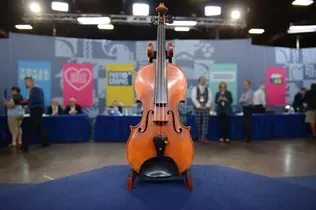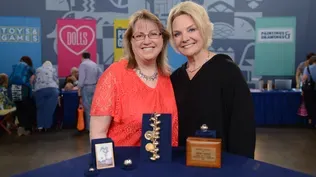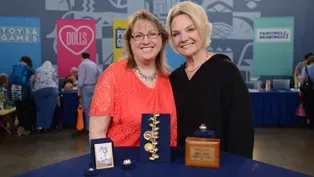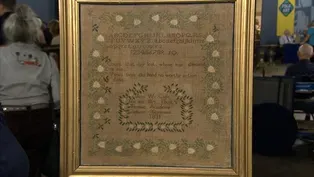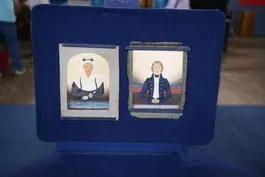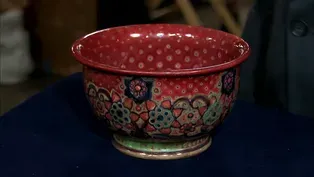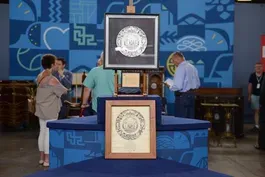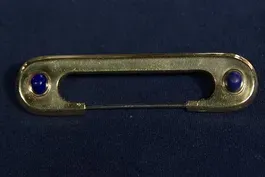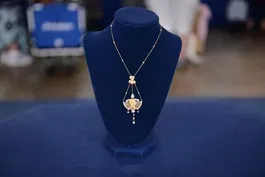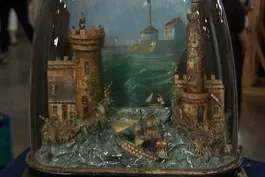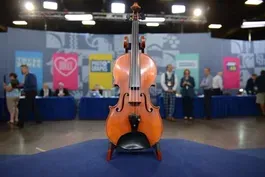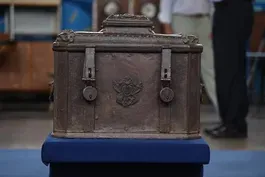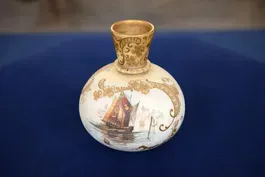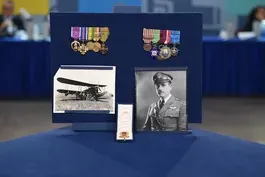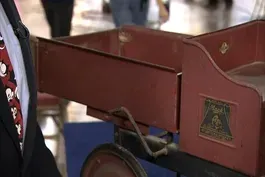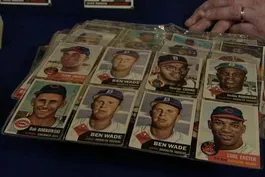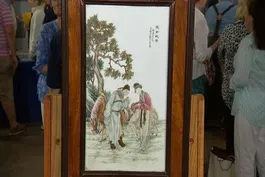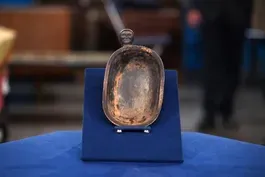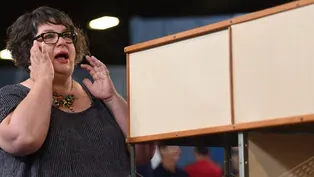

Fort Worth, Hour 2
Season 21 Episode 2 | 53mVideo has Closed Captions
A Felipe Orlando oil, a baroque lockbox, and a Green Bay Packers championship group!
Discover Fort Worth’s hidden treasures including a Felipe Orlando abstract oil, ca. 1980, a German baroque lockbox from around 1625, and a Green Bay Packers championship group, ca. 1965. Can you guess which is valued at $75,000-$200,000?
Problems with Closed Captions? Closed Captioning Feedback
Problems with Closed Captions? Closed Captioning Feedback
Funding for ANTIQUES ROADSHOW is provided by Ancestry and American Cruise Lines. Additional funding is provided by public television viewers.

Fort Worth, Hour 2
Season 21 Episode 2 | 53mVideo has Closed Captions
Discover Fort Worth’s hidden treasures including a Felipe Orlando abstract oil, ca. 1980, a German baroque lockbox from around 1625, and a Green Bay Packers championship group, ca. 1965. Can you guess which is valued at $75,000-$200,000?
Problems with Closed Captions? Closed Captioning Feedback
How to Watch Antiques Roadshow
Antiques Roadshow is available to stream on pbs.org and the free PBS App, available on iPhone, Apple TV, Android TV, Android smartphones, Amazon Fire TV, Amazon Fire Tablet, Roku, Samsung Smart TV, and Vizio.

ANTIQUES ROADSHOW 2025 Tour!
Enter now for a chance to win free tickets to ANTIQUES ROADSHOW's 2025 Tour! Plus, see which cities we're headed to!Providing Support for PBS.org
Learn Moreabout PBS online sponsorshipMARK WALBERG: "Antiques Roadshow" rounded up some of the best treasures of Texas, in Fort Worth.
I've never seen anything like this object on the Roadshow, and I've been doing it 21 years.
That's great!
That is great!
(laughs) WALBERG: It isn't "Antiques Roadshow's" first trip to Texas, but it is our first time in Fort Worth.
This proud cow town is home of the Texas Cowboy Hall of Fame, where we discovered many fine examples of wagons of the past, from the humble buckboard to the very fancy surrey with the fringe on top.
What treasures rolled into Roadshow?
Take a look at this mid-century beauty.
I bought this at an auction from an artist who was well-known in the area.
I was excited to go to the auction.
I actually postponed a hernia surgery to attend the auction.
When I went to preview the auction, I suspected it was Eames, and then when I looked in the drawer, I knew it was.
And so I sat through the whole auction and I won the bid, so...
The cabinet is designed by Charles Eames for the Herman Miller Furniture Company.
In the original catalogue from 1952, it was known as the ESU series, ESU standing for "Eames Storage Unit."
This exact model was known as the ESU 420-N.
The "N" designation is for the neutral color palette, "400" is because of the 400 series, and "20" designation is for the drawers and door combination.
It was designed at a time when manufacturers and designers were teaming up, and the best design minds were being paired with some of the best manufacturers.
All of these parts were custom manufactured.
There's actually 341 pieces on this cabinet.
Wow.
I counted them this morning.
Wow!
You're crazy.
(laughs) There's a lot of companies today that are very successful with producing something that comes in a flat pack and is shipped out and the consumer actually puts it together.
Right.
This was far too complex for a consumer to assemble themselves.
So these all had to be made in the factory at Herman Miller in Zeeland, Michigan.
They all had to be assembled there, then put in a large cardboard carton and a crate and shipped out by rail or truck in 1950 across the country to their destination.
And that actually proved to be a little too expensive, and also the design of the item suffered in transit.
The biggest flaw of this design is that the legs are very thin and are designed to take a lot of weight compressed straight down, but they're not designed for lateral movement.
So in shipping, or when you pile a lot of heavy items on top of this and then you want to move it even just an inch, those legs can kind of give way.
It has a label here in the drawer.
That label is from the early 1950s.
The reason I know this is from between 1950 and 1952 is that in 1953, this entire cabinet was redesigned.
Oh!
The weakness of the legs... Was fixed?
...was fixed, and new legs were designed that were inset into the bottom.
This version, which was commonly referred to as the first series version, has these original legs.
How much did you pay for it?
$15.
In 1952, these were about $200, which was fairly reasonable.
In today's dollars, that would be about $1,700.
There's few of them that survive in good condition.
I would call this one of the best survivors I have ever seen, and I specialize in this type of design.
Wow.
At auction, which is probably the most common place that these would show up today, I think this would sell for about $20,000.
What?!
Really?
Yes.
Uh... (tearful laughter) Really?
Yeah.
Wow.
I was going to be cool.
I had no idea.
I thought maybe $800.
I have two like this and two small ones, and we love them.
Oh, I had no idea.
Wow, that's very cool.
Wow!
(laughs) I had no clue.
WOMAN: It's been in my family since I was a young child.
It hung in the bedroom of my parents' home, and then I ended up with it.
We've sort of just taken it for granted or not really paid much attention to it, and then last minute, I decided to bring it in today and see what you could tell me about it.
It's an interesting painting of cats, and cats are a theme that you see in art going all the way back to antiquity and right through to the present.
One of the things that's interesting about the painting is it's signed, of course, here.
Right.
And the artist is Julius Adam.
There's a little bit of confusion because when you look at the plaque that's put on the frame...
Right.
...it says "Kitten Symphony" is the title, and then it says "Julius Adam," and it says "1826" to "1874."
Julius Adam is the name of two painters.
There was a father and a son.
Julius Adam Senior...
Okay.
...is the artist whose dates comport with what's on the plaque.
Okay.
Julius Adam II is the artist we believe painted your picture.
And Julius Adam II, who is from Munich, Germany, was born in 1852 and died in 1913.
I don't think there was any intention to deceive.
Julius Adam the son studied under the father...
Okay.
...and like his father was a cat painter.
His father tended to paint a little bit more equestrian themes than cat-related themes.
Somebody has put on the title "Kitten Symphony"...
Right.
...which was probably added later.
The painting is an oil on canvas.
While the artist did go to Rio for a period of time, this was most likely painted in Germany in the late 1800s.
This kind of theme is very popular today.
You have auction houses that have auctions just of cat themes, just of dog themes.
Really?
There's a strong market for works by Adam, and if offered today at auction, your painting would be worth $8,000 to $12,000.
Wow.
Okay.
What do you have there?
A ship in a bottle.
A ship in a bottle.
Did you make that ship in a bottle?
Heavens, no!
(laughs) So I have two that I know absolutely nothing about other than my brother-in-law's parents probably picked them up in Vietnam when they were there in the '60s.
Where'd you find this baby?
Well, it was my dad's.
I'm thinking it's gotta be '20s or '30s, but I don't know a whole lot.
My husband and I, we helped my dad tear the garage down.
He said, "Take all this stuff home," and it has sat in my house ever since.
Well, this is a Steelcraft pedal car Mack dump truck.
It's a classic piece with a dump action for kids to play with.
All sorts of action... (loud whirring) But what really makes this unusual is it's in amazing condition, even though it looks a little nicked up.
It dates from the mid-1920s, and you just almost never see these in original condition.
Usually they're restored.
But I would say at auction in this condition, it could easily bring somewhere between $1,500 and $2,000.
Wow.
WOMAN: My grandfather was the owner of a jewelry store in Fort Worth, and he did loans and sales and everything in the world.
And evidently he bought this from someone, gave it to my mother-- he had four daughters, and she lucked out and got this.
And she gave it to me.
I don't know much about it, no signature that I could find.
And when would you say your grandfather's store was open in Fort Worth?
Do you know the dates of the store?
Late 1800s, probably into the '40s.
And the convention center is now standing where his store was.
Well, how fun that we're here today.
The necklace is back where it started, I suppose.
Right, I think so.
Well, what we have here is an American Art Nouveau necklace.
It's from the Art Nouveau period, which dated from about 1890 to 1910.
It's set in yellow gold.
We have freshwater pearls, a little diamond and diamond accents throughout, and beautiful plique-à-jour design.
Plique-à-jour is a French term.
It means "letting in the daylight."
And so it's this enamelwork around this beautiful woman's face, and there's no backing to it, so the light can shine right through it.
Very pretty profile of a lady, typical of Art Nouveau jewelry.
I was not about to find a signature on this piece either, so I don't think we're going to be able to find out who made it.
I think it dates to about 1910, just the end of the period.
It's in wonderful condition.
Where have you been keeping it all these years?
I hate to tell you: in a box.
I took it out one time to wear it on a black cocktail dress because it shows up nicely on black background.
And my grandson was looking through my jewelry in a drawer and he said, "What's in the blue box?"
And I said, "Oh, what was my mother's necklace."
He says, "Grandma, you should wear it!"
(laughs) He's so funny.
Well, he has very good taste, I would say.
Today, at auction, I would expect it to bring somewhere between $4,000 and $6,000.
Wow, that's a lot for a necklace that sits in a box.
(chuckles) I think I'll start wearing it.
(laughter) I think you should.
Yeah.
WOMAN: I brought you a 16th century metal-clad Spanish armada chest.
The term "armada chest" is one of those terms that gets applied to antiques like this.
There may be some oral tradition that linked, at one point, one of these chests to a ship in the Spanish armada and maybe that nickname stuck, because there's no real evidence that these chests had anything to do with the Spanish armada.
Tell me the story of how it came to you.
My dad was in the military, and after World War II, he was stationed in Salzburg, Austria.
Okay.
He was also an artist, and he enjoyed antiques and collector items.
And he met an Austrian who told him that he could help him acquire a rare antique.
He did so a year later, after 1949, and this chest is supposed to have come from Maria Theresa's palace, the Schönbrunn Palace in Vienna, Austria.
What was paid for it, do you know?
I don't have any idea.
There's a button on the side here, and that lifts up to reveal this incredibly massive key, very intricate in its design, that fits directly down into the locking mechanism.
We turn it, it's activated a very elaborate locking mechanism inside that we can reveal.
I'm going to lift this up, and if you can help me...
Okay.
...support it, we can bring these up.
And we'll just put that at the top notch there.
You can see this locking mechanism covered by this engraved brass cover.
The latch in the middle here, a bolt there, a bolt here, and they continue around the side.
We counted about 15 different bolts that are activated by one key.
The locking mechanism is really, truly amazing.
So this chest comes out of a tradition of German-made lockboxes made famously in Nuremberg, but also in Augsburg, Germany.
Those blacksmithing traditions sort of came into their own in the late 16th and early 17th centuries, and this is probably a 17th century example covered in baroque embellishments.
And let's go ahead and close, so I'll pick this up... And it'll just fall.
Our supports will... Yeah, drop.
Drop.
And as you can see, there are padlocks on the front.
These are probably 19th century padlocks.
The elaboration really is something.
They have these applied floral devices, this applied plate in the front meant to make you think that's where the lock is.
This piece of cast iron is essentially sculpture.
It would be desirable for more than just the fact that it's a German lockbox.
In an auction, conservatively, I would say that it might bring $10,000 or $15,000.
That's great.
My mother actually purchased it in 1998 in Santa Fe.
She was shopping and saw this in the window, and she walked in the store and she said, "I want that," and they said, "Well, we just hung it up."
She said, "Well, take it down, because I want that."
So the little that we know about it is that it was, we think, made in India, hand embroidered using pieces of dignitaries' wives' dresses, mainly the collars and the cuffs of their dresses.
And supposedly there's 24-karat threads in here.
And what did you pay for it?
$1,250.
Okay, I've never seen anything like this object on the "Roadshow," and I've been doing it 21 years.
You've heard of crazy quilts.
Crazy quilts are pieced quilts that are American.
This is really the northern India version of a crazy quilt.
Now, we can't confirm everything that you said about the dignitaries, but they are definitely pieced segments and they are of various ages.
You could certainly have pieces in here as early as 19th century, some that are 20th century.
We believe it was definitely put together in the 20th century.
Right, right.
You mention the gold thread.
I think certainly a lot of the thread is metallic.
And I want to talk briefly about two different markets.
Okay.
In fine art, you have objects that would be, like, classical rugs from this area, you have paintings.
These are objects that would go into the fine art market.
Now, if this went into the fine art market, it probably wouldn't have a great deal of value.
What really makes this piece so exceptional is the size and the impact, and I'll tell you right now, this is absolutely a killer piece.
Oh, good!
I love this piece.
I would say at a good auction or in a decorative showroom, you could see this thing easily at $5,000 to $7,000.
Oh, that's great!
That's wonderful.
♪ ♪ Some of the elaborate ones that are blue and white... Yeah.
...are a little bit more money.
I'd say you're probably looking at, you know, $250 to $350 for this set.
It's really nice, and it's great that you have a family connection to it.
It has really great colors.
The whole design of it is very graphic.
It's like a piece of art.
It's really beautiful.
For something, you know, made in Macon, Georgia, pre-Civil War, 1840s, 1850s, it's just a really rare and unusual cup.
You could easily see this selling in the $3,000 to $5,000 price range because they just don't exist.
WOMAN: It was a gift from my husband and I know very little about it.
I've worn it as a pin on a coat or a jacket.
It's 18-karat yellow gold.
It's kind of this oversized... it's not a safety pin, but it's got kind of that look.
Yes.
And on the end, you've got these blue stones.
You know what they are?
I think they're lapis.
You're right, lapis lazuli.
And they're cut in this very high dome fashion, cabochon.
If you look right over here, there's a tiny, tiny little hallmark that's an eagle's head.
Oh, really?
I never noticed that.
That tells me right away it's from France.
So we know it's French.
Oh, really?
Now, design-wise, it's absolutely 1940.
I'm not sure if you know this is here.
On the inside, it says it's made by Cartier, and it's signed there.
Yes.
And then next to it, it says "Paris," so that confirms the French hallmark.
And then also if you look just to the other side of where it says "Cartier Paris," there's tiny little numbers, there's five numbers.
That's very important when you're trying to authenticate Cartier pieces because a lot of times you'll see pieces, you know, they may not be so correct.
Uh-huh.
You'll see the signature, we won't see the numbers.
Sometimes you see numbers, you don't see the signature.
Here, you've got everything wrapped up in a neat package.
Oh, great!
I would say, at auction, $6,000 to $8,000.
You're kidding.
Wow!
I love it more every day.
(laughs) WOMAN: I went to college in 1968, and my instructor told me that I needed a better violin than the one I had, and we paid $600 for it, which was a lot of money back then.
APPRAISER: In 1968, you're right, $600 was a lot of money.
What did you understand the violin to be when you bought it?
Well, we were told it was an original instrument.
Okay.
The label inside, of course, didn't mean a lot to me, but we were told it was at that point about 100 years old.
Well, the label on the inside says "JB Vuillaume, Paris 1861," and it has a signature on it.
Your understanding was that it was an original what the label says, a JB Vuillaume.
Correct.
Has anybody ever contradicted that?
No.
All right, all right.
Well, I'm a big fan of the work of JB Vuillaume.
He started work in Paris about 1820, he died in 1875, and he was a really prolific maker.
What's interesting to me is that the signature is on the label, but it's not written on the inside of the instrument, so it contradicts anything that Vuillaume was known to do.
And in 1861, he didn't put his date on the label; all he did was number them, and we know that certain numbers correspond to certain dates.
So the label made me very concerned.
But I kept looking at your violin, and it's a really beautiful French violin.
Do you have a sense of what it should be worth?
I have no earthly idea.
It could be worth anything as far as I know from $10 to $100.
Well, I looked at the craftsmanship and the things that I noticed were how beautiful the purfling goes into the corners, the absolute fine, fine craftsmanship.
So I thought, "This is somebody who knew what they were doing."
Okay.
The conclusion that I came to is that indeed this is a French violin, and the date on the label is not far off, but I would put it more after the death of JB Vuillaume, around 1880.
And there were some workers that worked for Vuillaume who continued working, and one of them was Derazey.
Now, I can't 100% say that this is a Derazey, but it is of the quality of the work of Derazey.
Okay.
And I would value this violin in the retail market today at $25,000.
Oh wow, that's great!
That is great.
It's wonderful.
So I think you picked out a beautiful violin.
Thank you!
WOMAN: I bought it on a wedding trip 22 years ago on the island of Kauai.
I fell in love with it.
I think it's an effigy bowl, I'm not really sure.
Do you have any idea where it's from?
I always called it Pacific Northwest, maybe Eskimo.
I think you're right.
Really?
Oh, good.
I think it's definitely Eskimo, and it's a remarkable object.
First of all, it's made out of spruce.
It's a fairly soft wood.
And it's quite extraordinary.
I mean, I have never seen, and my colleagues also, one that has this head fixed on the top.
The Eskimos don't really do decorative art.
Everything they do has a function.
And they also believed that each of these objects has a spirit in it, the yua, and I think that the head probably represents the spirit of the bowl.
Mostly, you see these as finger puppets, and it's a strange notion.
I mean, maybe this is meant to look like a mask and this is the body.
One is inclined to think that it would be ceremonial.
I mean, we don't really know.
Right.
The back, you can also see, it's actually hollowed out, which makes me think it is a mask in miniature.
Very nice grooved carvings around the side here, traces of pigment.
There's been some damage, which has been repaired.
I don't know when-- before you got it, I think.
Right.
The bowl I think is probably the beginning of the 19th century, which is early for this material.
It could even be earlier-- 1780s, 1790s.
How much did you pay for the group?
$400.
Okay, so do you have any idea, what do you think it's worth?
I'm going to throw out a number: $1,500, maybe?
I will put a price of, say, between $18,000 and $20,000.
Oh, my goodness.
And I think with more research... That's a retail price, and I think at auction, it possibly could go much higher.
Oh, my Lord.
But I like to be conservative about this, and I think $18,000 to $20,000 is a conservative price.
It's really a remarkable object.
This is my wedding gift.
Makes me want to cry because of the history of where I got it and how I got it.
A friend told me about an estate sale in Dallas, so my son and I decided to go.
We went on the last day of the estate sale.
When we entered the house, I saw this leaning against the dining room wall on the floor, and I was just drawn into the red color.
I'm not an abstract collector.
I don't know anything about abstract.
I'm very more traditional.
Being that I'm Hispanic, I just saw, like, a flamenco dancer sort of like with the red hues.
It just spoke to me in that manner.
When I told my son I wanted to buy the piece of art, he said, "Oh, Mom, don't get it, it's ugly."
But I decided to go ahead and purchase it and ended up paying six dollars for this piece of art.
Six dollars?
So how long ago did you purchase it at the estate sale?
About four to five months ago.
Your son should always listen to you.
Sons should always listen to their mothers.
But this is a really interesting example of an abstract painting by the Cuban artist Felipe Orlando.
It's oil on canvas, and Orlando was an interesting artist in that he was born in 1911 in Mexico, but spent the bulk of his career in Cuba from 1914 until 1946, which is a very vibrant time to be in Cuba.
He was influenced by artists like Tamayo, and also European artist Jean Dubuffet.
But when we look at paintings like this, his own instincts for the Afro-Cuban style, as well as his interest in pre-Columbian anthropology comes through.
It's quite abstract, but there's a lot of figure studies going on and a lot of Latin American tendencies in the abstraction, in the movement, in the palette.
It's really a wonderful example of his work.
The piece is signed and measured on the back, and also the artist has put an arrow to show which way is down.
The typography corresponds with that direction.
In the '50s, the artist moved back to Mexico, and this was probably painted in the 1970s or '80s.
His work is in the Museo Nacional in Havana as well as in the Museum of Modern Art in New York and at the Museum of Latin American Art in Washington.
So, a very established artist.
It's in great condition and, at auction, I would estimate it at $4,000 to $6,000.
Wow.
Wow, not a bad investment.
If it were earlier and painted in Cuba, it would have a different scale of value.
WOMAN: I have a jacket from my dad's first cousin he got in Shanghai, China, in 1946.
I would put a value of $125 on it.
Oh, cool!
Somebody's added tacks, they've done some file work on it.
It is a usable thing, it's just not old.
Okay.
WOMAN: You said the 1800s?
Yeah.
Oh my goodness!
I love it!
Well, it can continue to hold pinecones.
(laughs) WOMAN: So I brought an antique sampler that I inherited from my father, who inherited it from my great-grandmother, his grandmother, who is from Nashville, Tennessee.
Her maiden name was Franklin, and the Franklins are a big family in Gallatin.
This came into the family, we think, through a distant marriage to somebody in the Cage family.
One of the reasons we want to share it with our viewers today is because indeed it is signed by the Female Academy in Gallatin, Tennessee, and dated 1831.
The schoolgirl samplers were primarily created up north, and when people think of a schoolgirl sampler, they think of the Boston school, they think of the Rhode Island schools.
And it's rare that we see a named school from the Southern states.
Wow.
This border over here is actually strawberries.
Oh!
And the day it was made, those would have been red.
Wow.
So it would have been very vibrant.
Yeah.
The material is a muslin material.
And the stitches, the thread is all silk.
It does have clear condition issues, with part of the material missing.
Right, the hole.
The fading on the color.
But the valuation is really based on the fact that it's from a rare academy.
We have seen one or two from this academy in Tennessee.
Its age, 1831, is just at the cusp of going out of style, actually.
Oh, okay.
The real heyday for the schoolgirl samplers were about ten to 20 years earlier than this.
So we love to see them from a Boston school from about 1810.
Okay.
But she was probably, at that time, she was probably 12 or 13 years old.
So they did these as young ladies, as an apprenticeship to show men that they could actually sew and be very fastidious in their stitching.
We're going to put a value on this today in the context of saying that it's a family piece, until you do further research, and we're going to put an insurance value on it today of $5,000.
Wow.
Because we have seen material from this academy sell for that price range, and I would think, as a family piece, you would want to keep it and just insure it for $5,000.
Well, that's great to know-- thank you.
MAN: It's my grandfather.
He founded the Air University at Maxwell Air Force Base, which was the precursor for the Air Academy.
And at the Air Academy, the academic building and library is named after him.
The gentleman's name is Muir Fairchild.
Right.
And if you are interested in United States Air Force history, you know the name Muir Fairchild because he had a very long and distinguished career.
But how did he come to be interested in aviation?
It wasn't so much a question of getting interested in aviation as in getting uninterested in horses.
He began chasing Pancho Villa as a young cavalry guy, I guess.
And he volunteered for air service and became a test pilot and flew a number of different aircraft.
And the one that he was probably most familiar with is the one that's pictured right there in that photograph.
It looks like a boat because it was flown in places where there'd never been airplanes before.
Five of them took off and were meant to circumnavigate all of Central and South America.
Of the ten pilots that took off, eight of them returned.
The eight that returned were among the first recipients of the Distinguished Flying Cross.
In that giant career, this is the event that really stands out.
Yeah.
And the one that we have represented by the artifacts today.
We lose track of how dangerous aviation was.
This was all part of the Pan American Good Will Tour of 1926, which was a very significant moment in aviation history.
They hit all these different South American countries on good will stops, promoting aviation.
Aviation's in its infancy, and a lot of these military officials hadn't seen military aircraft at this point.
So they're coming in with these flying boats, which are rather interesting aircraft.
They have the engine mounted upside down so that the prop will clear the bottom of the fuselage for a water landing.
You don't want your prop hitting the water.
But it was a very dangerous exercise, and they did end up losing two fellows.
One of the fellows had gone out on the wing to lower the landing gear because there was a problem.
And they had a mid-air, at that point.
He had taken his parachute off, and the pilot, rather than let him perish on his own and jump to safety himself, he tried to rescue him and it couldn't be done, and they both lost their lives as a result of that.
But it was a very dangerous exercise, a very bold exercise that was done at that time.
And at every stop they would have a reception, and they would get medals.
The medal over here that is of particular interest to us is the Distinguished Flying Cross, and we can see on the back of this, it is engraved with his information and his name.
This one is also indicative of this event.
This is the Mackay Trophy medal.
The Mackay Trophy is kind of like the Stanley Cup.
It's the big aviation award from 1912 that was awarded for the most important flight of the year.
There weren't that many individuals at this time who had received such a thing.
The individual medals themselves-- especially when we're talking about the South American awards-- if you found them out in the world yourself as a medal collector, you wouldn't expect to pay a whole lot for them.
They average between $100 and $300 apiece.
But with what it means to aviation history and his significance to the United States Air Force, an auction estimate for the entire set would be between $15,000 and $20,000.
Wow.
Well, it's our intention as a family to return all of these items to the Air Force at the Air University at Maxwell Air Force Base.
WOMAN: In 2011, my mom brought the doll to me in a box.
She came to our family in 1884.
She's been passed down from different generations.
This is Marie Lovell.
APPRAISER: Okay.
And how was it determined who got the doll when it was passed down?
From what I understand, it was passed down to, like, the next generation ten-year-old.
Each party that had it had a period dress made.
Your doll is a Jumeau doll, what we call a Jumeau Portrait Fashion.
And it's made in France, about 1884, when the doll was first purchased by your family.
And it's on a very different body.
It's on a body that's not usually on this French head.
It's a German body.
But the more important thing is it's got the wonderful French head.
Her hair is a human hair wig, and it's not original to the doll.
The doll would have had a mohair wig with long hair that comes from goats.
Unfortunately, it appears that the clothing from 1884 is missing.
The dress she's wearing is made later, probably in the late 19th century.
We have the white dress, which I believe in your provenance was made in 1908, also includes her petticoat and other underwear.
Then we have the black dress, which I believe was made in the 1930s.
Okay.
Then we have the one on the end was made in the 1940s.
Includes underwear here, a camisole here, and a handbag.
Do you know if everybody that got the doll made a dress?
From what I can tell they did, other than my mom.
Your mom didn't make a dress.
And she did not, I don't know why.
But maybe I'll make one for her, but my plan is to, since we live in Oklahoma, I live in the Cherokee nation, I want to get a Cherokee tear dress made.
Oh, how wonderful.
But aren't you supposed to make the dress?
(chuckles) Did they make those dresses?
I don't know, I guess I could try.
Oh, okay.
If I were to give an award to the most nicely made dress, it would probably be the white lace one that is really a beautiful period dress from 1908.
So, you're probably curious to know about what it's worth.
(inhales) I'm anxious to hear.
Okay.
On the retail market, the group-- the doll, the clothing-- is worth $3,500 to $4,000.
And... Say that... three?
$3,500 to $4,000.
Wow, wow.
If all the clothing was from the 1884 period, it really would increase the value.
WOMAN: My grandfather and his three siblings were orphaned.
His sister was young enough that she had to go live with family, so she went to live with her mother's first cousin in a house in Pensacola, Florida.
When she died, she was the last of the family members to live in that house, and my dad and his brother inherited the house and its contents, and this was part of it.
And did your family do something else with this?
At some point early, I suspect in the 1900s, my mom says when electricity became popular in homes, they had it wired to be a lamp.
And they did not actually drill a hole in the bottom.
The wire for the electricity came out the top.
But she didn't like it as a lamp, so she got rid of that, put it on the piano as a vase, and it's been mine for about 20 years.
If they had actually drilled the bottom of this, or if there had been damage done from making it into a lamp, you and I wouldn't even be having this conversation.
Okay.
What do you think it's made out of?
Well, we thought it was porcelain, and the gentleman at the very beginning of the day said, "No, that's glass.
Here's your ticket."
Okay.
So the truth is I have absolutely no clue of anything.
Well, the interesting part about this is that this was made to look like Royal Worcester porcelain.
Okay.
And this was made by the Mt.
Washington Glass Company.
And at this point they were located in New Bedford, Massachusetts.
Okay.
And when it was first introduced in 1886, it was called Albertine.
And it was supposed to compete with Royal Worcester, so this is made out of white opal glass, but they put a satin finish on it to make it look like porcelain.
So it would easily be mistaken.
Be mistaken.
You didn't find any mark that said "Albertine" on it, did you?
No.
Okay, what you did find was the mark down here, which is a monogram with a crown over it.
The monogram is "CM" for Crown Milano.
The Mt.
Washington Glass Company filed the papers in January, late January 1893 to change the name from Albertine to Crown Milano.
So we know when they started marking it like this, it has to be from 1893 on.
So the way it is decorated, it's an enamel decoration.
A stencil was used, so you have the rich enamel in the foreground depicting the boats and the sails, and then a very faint gray paint or enamel in the background depicting Venice.
And then to enhance it, you have the raised gilded design sort of framing it in these little vignettes.
In a retail shop, it would bring between $2,000 and $3,000.
Wonderful.
I'm not going to sell it.
It's going to go back in my cabinet.
Made in 1600s in England, I think.
The clock was probably made about 1825 to '35.
So it's still an old clock.
You have a stencil design over here, and then you have a transfer decoration here.
You have a nice pair that would sit on a mantel and probably, you know, fun for whoever bought them.
But not a lot of dollars today.
This is the most curious magazine I've seen today, or in some time.
"Prosecuted for Blasphemy: Freethinker."
I just love this.
"William James Ramsey, as proprietor, sentenced to nine months imprisonment."
And oh, profane jokes.
We're not reading any of those.
MAN: It is progressive proof plates from "Les Affiches Illustrées."
This is Toulouse-Lautrec, and that's about all I know.
"Les Affiches Illustrées" was a book that was done catering to the poster collecting community in the 1890s.
Posters were a craze sweeping France, and the original posters-- which were five feet high by three and a half feet wide-- were too unruly to collect, and so people really began to collect these smaller versions of the posters.
The book was printed in 1896.
The poster was done a few years before that.
Now, in the book, all they would have is the finished, full-color lithograph.
But what you have is the progressive plates.
Each color that appears in the final poster was done on an individual lithographic stone.
And when they overlay on each other, they come up with the final image.
How much did you pay for these?
About 250 euros, which was I think approximately $280.
The poster is fantastic.
This alone, at auction, would sell for between $700 and $1,000.
Okay.
Now, the progressive proof plates, they are phenomenally interesting, they're phenomenally important.
But posters really are an aesthetic medium.
So the fact that they don't look that good makes them less appealing to collectors.
With the group of four color proofs, you're probably looking at $1,500 to $2,000 for the group of five.
That's great, that's great, great news.
MAN: I grew up with them hanging on the dining room wall and never really knew who they were as a kid.
But as an adult I determined that they are two of my great-great-great-grandparents on my father's side-- Thomas and Elizabeth McCullough.
I received them from my parents when they passed away in 1959.
Yeah, if you look right over here, it's got the date.
Yes.
1832.
Yes.
According to the census record we found, they lived in Fairfield, South Carolina.
Yes.
Fairfield, South Carolina, is sort of back more in the middle of the state.
Yes.
And due north of there is Greensboro in Guilford County, North Carolina.
And once we took these out of the frames and I started looking at the way they were done, I realized that I recognized the artist.
Oh.
Which in folk art is one of those "aha" moments, kind of makes the hair stand up on your arm.
Yes.
And this guy is called the "Guilford Limner."
Limner?
Limner, L-I-M-N-E-R. And basically, he was an itinerant artist, and there's a group of watercolors that came from Guilford County that are all from the 1820s.
And he never advertised in the paper, nobody knows where he went afterward or what he did.
And I think this is an exciting discovery for several reasons.
First of all, it's more than ten years from the other time period that we're looking at, the ones that we know about.
And if this guy was an itinerant artist, it would have made perfect sense that he would have gone to wealthy people's homes and done portraits.
The characteristic of his work is these very striking faces.
He did a combination of watercolor and, I think, gouache, and maybe even a little bit of pastel.
And one of the very distinctive things you see is the way this background right here is done.
That is like a dining room wall, and that's probably a chair rail.
And then he made this look like it was paint decorated.
I found that both of your relatives were born in the 1780s, and they both died in the 1840s.
I think she died in 1848 or '49, maybe six years after he did.
And I just can't tell you how excited I was to realize that we solved... we found some more of these portraits by a known artist.
Better than that, we even know who the art... and you're directly descended.
That is exciting.
I thought they were just family portraits.
Yeah, well, most people would think that.
Not many of these exist, very few of them have ever been on the market.
And so we decided to err on the side of caution and say that an auction estimate for these would be $20,000 to $25,000.
Wow, that's unbelievable.
WOMAN: My brother and his wife bought these for us for a wedding present 24 years ago.
And they know how much that I love Texas history, and history in general, as a fourth-generation Texan.
APPRAISER: What are we looking at?
Well, this is a unfired bisque plate honoring Texas in the 100-year, centennial anniversary of the birth of Texas, which was in 1836.
And I'm assuming this was somewhere around 1936 when it came out.
So in 1936 was the 100-year anniversary of the independence of Texas from Mexico.
Yes.
Several years later, we became a state.
Right.
But in Texas, it's all about independence.
In 1936, there was a huge exposition in Dallas.
Oh.
It had been planned for a very long time, and thousands of people from all over the state came to Dallas to go to this big fair and exposition.
And one thing you could do is buy souvenirs, and there were hundreds of different types of souvenirs.
And because Texans are so loyal to their state, there's lots of people that collect those these days.
Right, right.
Now if we look at this plate, it's very well designed.
It was made in England by Wedgwood, and the Wedgwood company had a division which made commemorative plates.
Oh, wonderful.
And on this plate, they have Stephen F. Austin, we have Sam Houston, in the center is the Alamo, and all kinds of other scenes of Texas history and historical Texas places.
So obviously, this wasn't probably made in 1936, it was made before that.
So it was probably made a year or two before.
And down here is like a print of what the plate's going to look like, should look like.
Right, right.
And beneath it is wording that tells about the plate, and it's exactly as the wording appears on the back of the plate.
Okay.
And then here we have an interesting little presentation plaque where this was presented to the DAR chapter in Austin, Texas.
Okay.
The DAR being the Daughters of the American Revolution.
Okay.
Now, why this left the DAR chapter, I have no idea.
I don't know.
But it was at one point owned by them.
Now, as you said, this is an unglazed plate.
Yes.
And when it was fired the final time, it would have been covered with glaze and fired, and it would have turned blue.
Okay.
So the plate that was actually sold at the centennial is blue.
Wow.
I have seen at least 200 of the Wedgwood Texas centennial plates in my life.
Okay.
There's a lot of them out there, a lot of people bought them as souvenirs, and collectors now like them.
Okay.
And they usually sell for around $100, a little more, a little less.
So how much is an unglazed plate worth?
I'd never seen one.
So I talked with another appraiser, who's also interested in Texas history and collecting Texas memorabilia, and all we can do is speculate.
Okay.
Our best guess is that a retail price for this group would be somewhere between $1,000 and $2,000.
Wow!
I think it's really a spectacularly rare and unusual... Yeah, I love it, yeah.
...example of Texas history.
But also of the manufacturing of a plate and what a plate looks like when it's unglazed.
Yeah, and it came from England, I mean that's... that's crazy.
That's wonderful.
You guys are the daughters of an NFL Hall-of-Famer, Henry Jordan.
Yes.
Right.
Our dad died in 1977, and after he died, my mom split up the jewelry amongst us.
And your father played defense.
He was defensive tackle, and at the time, he was the smallest defensive tackle in the NFL.
He has a lot of cards out there, and they all say something different, but he was maybe 6'2" on a good day.
Very, very fast.
He was known for his incredible speed.
That's his thing, he was... And very agile.
He was an agile defensive tackle.
Yes.
He could get to the quarterback with... and at the time, sacks were... they didn't keep track of them.
Right.
So who knows.
One of the other things he was known for, he did a lot of speaking engagements, and he was known for his wit.
He was a very funny man.
One of the famous things that he's known for saying is, "Lombardi treats us all the same-- like dogs."
(chuckles) And you brought some souvenirs that you've inherited from your dad.
What do you have here?
In 1961, the Green Bay Packers won a championship, and they received a ring.
At the same time, the wives received a companion ring, which is this one right here.
And in 1962, they won a championship and they received a watch.
That's not in this collection here.
In 1965, they won again, and won this ring right here.
And that was called a World Championship ring.
In 1966, they won again, and that was when they changed it to Super Bowl I, and that is this ring right here.
They also won again the third year in 1967, for Super Bowl II.
And so they had a three-peat, and people just forget because this ring here is not called Super Bowl.
So the Packers have a proud tradition of winning is what you're trying to tell me.
Yes.
And not to be outdone, as you said, the 1961 wives' rings, they got their own ring, along with the players.
You've got the last NFL Championship ring and the first Super Bowl ring.
And in the middle you have a charm that's a combination of what exactly?
When the team won, the wives would get a charm.
And so this is a charm bracelet.
It has different years for all the different divisional championships.
Or this one here is an Outstanding Lineman in 1962.
This one is a medallion that says on the back, "Seven-Time All-Pro, Five-Time Pro Bowl."
And then we've also got this one was to commemorate the Super Bowl I ring.
So in 1959 Vince Lombardi traded for your dad.
Yes.
To bring him from Cleveland to the Packers.
The rest is history.
Absolutely.
Let me ask you this: did your dad wear these rings?
He wore every one of them until a new one.
Once he got Super Bowl II, that is the one that he wore all the time.
Wore it all the time.
Not just on the holidays, not just when people were over.
He never took it off.
He was proud of it.
Well, he took it off all the time, but he wore it because fans and friends wanted to try it on.
That's great.
And you got to meet some of these players.
You were there.
Yes.
We grew up with them.
You grew up with your Hall of Fame dad.
He had a prolific NFL career, was inducted into the Pro Football Hall of Fame in 1995.
You guys have any idea of the value?
No, not at all.
A lot of sentimental value.
Certainly, you can't gauge that.
I'll give you two values here.
At auction, combined, this would bring $75,000 to $100,000.
Really?
Wow.
We think insurance value is between $150,000 to $200,000.
As you said, you really can't value it.
The sentimental value is enormous.
That's fantastic.
Yeah, when this came in we were thrilled.
My eyes...
I lit up.
(laughing) And you're still Packers fans, right?
BOTH: Absolutely.
WALBERG: You're watching "Antiques Roadshow" And now, it's time for the Roadshow Feedback Booth.
We don't think we're going to get to retire on our treasures today.
We had a great time.
So now we're going to have to use our backup plan.
♪ My singing.
♪ I actually found it whenever I went up in the attic, I saw these eyes looking at me, and I reached in the dark, and this is what I came out with.
This one is a fertility plaque used in the church if someone had become pregnant after not being able to conceive.
They made these and gave them to the church as a thank you.
In my case, I'm kind of hoping this is a fake.
Now we have secured our financial freedom and our retirement.
Her with her blanket and me with this beautiful Asian tiger that retails for $400.
Thank you, "Antiques Roadshow," you've made my dreams come true.
This item is something that I brought that my grandmother used to use as a doorstop.
And quite frankly, it will remain a doorstop.
I came to the "Antiques Roadshow" and met with wonderful appraiser Peter, who appraised my great-grandmother's crystal rhinestone set with the beautiful earrings, and the Trifari pin for $300 to $400.
And we're rich!
We're rich!
Thank you, "Antiques Roadshow!"
WALBERG: I'm Mark Walberg, thanks for watching.
See you next time on "Antiques Roadshow."
Owner Interview: Green Bay Packers Championship Group
Video has Closed Captions
Clip: S21 Ep2 | 1m 50s | Owner Interview: Green Bay Packers Championship Group (1m 50s)
Appraisal: 1831 Tennessee Sampler
Video has Closed Captions
Clip: S21 Ep2 | 2m 25s | Appraisal: 1831 Tennessee Sampler (2m 25s)
Appraisal: 1832 "The Guilford Limner" Folk Portraits
Video has Closed Captions
Clip: S21 Ep2 | 3m 25s | Appraisal: 1832 "The Guilford Limner" Folk Portraits. (3m 25s)
Appraisal: 1896 Les Affiches Illustrées Plate with Proofs
Video has Closed Captions
Clip: S21 Ep2 | 1m 39s | Appraisal: 1896 Les Affiches Illustrées Plate with Proofs. (1m 39s)
Appraisal: 1925 Galileo Chini Pottery Bowl
Video has Closed Captions
Clip: S21 Ep2 | 33s | Appraisal: 1925 Galileo Chini Pottery Bowl. (33s)
Appraisal: 1936 Texas Centennial Plate & Mock-up
Video has Closed Captions
Clip: S21 Ep2 | 3m 30s | Appraisal: 1936 Texas Centennial Plate & Mock-up (3m 30s)
Appraisal: 1940 Cartier Paris 18k Yellow Gold Pin
Video has Closed Captions
Clip: S21 Ep2 | 1m 28s | Appraisal: 1940 Cartier Paris 18k Yellow Gold Pin. (1m 28s)
Appraisal: 20th C. Northwestern Indian Rajasthan Textile
Video has Closed Captions
Clip: S21 Ep2 | 2m 28s | Appraisal: 20th C. Northwestern Indian Rajasthan Textile (2m 28s)
Appraisal: American Art Nouveau Necklace, ca. 1910
Video has Closed Captions
Clip: S21 Ep2 | 2m 40s | Appraisal: American Art Nouveau Necklace, ca. 1910. (2m 40s)
Appraisal: Continental Automaton Diorama, ca. 1890
Video has Closed Captions
Clip: S21 Ep2 | 1m 3s | Appraisal: Continental Automaton Diorama, ca. 1890 (1m 3s)
Appraisal: French Violin, ca. 1880
Video has Closed Captions
Clip: S21 Ep2 | 2m 41s | Appraisal: French Violin, ca. 1880, from Fort Worth Hour 2. (2m 41s)
Appraisal: German Baroque Lockbox, ca. 1625
Video has Closed Captions
Clip: S21 Ep2 | 3m 4s | Appraisal: German Baroque Lockbox, ca. 1625. (3m 4s)
Appraisal: Jumeau Portrait Fashion Doll & Wardrobe
Video has Closed Captions
Clip: S21 Ep2 | 3m 1s | Appraisal: Jumeau Portrait Fashion Doll & Clothing. (3m 1s)
Appraisal: Mt. Washington Glass Co. Crown Milano Vase
Video has Closed Captions
Clip: S21 Ep2 | 2m 57s | Appraisal: Mt. Washington Glass Co. Crown Milano Vase, ca. 1893. (2m 57s)
Appraisal: Pan American Flight Medals, ca. 1926
Video has Closed Captions
Clip: S21 Ep2 | 3m 55s | Appraisal: Pan American Flight Medals, ca. 1926. (3m 55s)
Appraisal: Steelcraft Pedal Mack Dump Truck, ca. 1925
Video has Closed Captions
Clip: S21 Ep2 | 51s | Appraisal: Steelcraft Pedal Mack Dump Truck, ca. 1925. (51s)
Appraisal: Topps Baseball Card Collection, ca. 1955
Video has Closed Captions
Clip: S21 Ep2 | 33s | Appraisal: Topps Baseball Card Collection, ca. 1955 (33s)
Appraisal: Wang Qi Painted Porcelain Panel, ca. 1930
Video has Closed Captions
Clip: S21 Ep2 | 2m 25s | Appraisal: Wang Qi Painted Porcelain Panel, ca. 1930, from Fort Worth Hour 2. (2m 25s)
Appraisal: Wooden Native Alaskan Bowl, ca. 1800
Video has Closed Captions
Clip: S21 Ep2 | 2m 21s | Appraisal: Wooden Native Alaskan Bowl, ca. 1800. (2m 21s)
Appraiser Interview: Herman Miller Storage Unit, ca. 1950
Video has Closed Captions
Clip: S21 Ep2 | 2m 11s | Appraiser Interview: Herman Miller Storage Unit, ca. 1950 (2m 11s)
Owner Interview: Herman Miller Storage Unit, ca. 1950
Video has Closed Captions
Clip: S21 Ep2 | 1m 18s | Owner Interview: Herman Miller Storage Unit, ca. 1950, from Fort Worth. (1m 18s)
Providing Support for PBS.org
Learn Moreabout PBS online sponsorshipSupport for PBS provided by:
Funding for ANTIQUES ROADSHOW is provided by Ancestry and American Cruise Lines. Additional funding is provided by public television viewers.


